Uxbridge: Difference between revisions
m Created page with '{{Infobox town | name = Uxbridge | county = Middlesex | picture = Uxbridge.jpg | picture caption = The Chimes and Uxbridge High Street | os grid ref = TQ055835 | latitude = 51.54…' |
No edit summary |
||
| Line 13: | Line 13: | ||
| constituency = Uxbridge and South Ruislip | | constituency = Uxbridge and South Ruislip | ||
}} | }} | ||
'''Uxbridge''' is a town at the very western border of [[Middlesex]]. It is a commuter town, at the end of the Uxbridge Branch of the [[London Underground#Metropolitan Line|Metropolitan Line]]. | '''Uxbridge''' is a town at the very western border of [[Middlesex]]. It is a commuter town, at the end of the Uxbridge Branch of the [[London Underground#Metropolitan Line|Metropolitan Line]]. Fifteen miles west-north-west of [[Charing Cross]], it is one of the major metropolitan centres identified in the London Plan.<ref name=london_plan_f08>{{Cite web |url=http://www.london.gov.uk/thelondonplan/docs/londonplan08.pdf |publisher=Greater London Authority |title=London Plan (Consolidated with Alterations since 2004) |page=351 |year=2008 |accessdate=10 November 2011}}</ref> The landscape upon which Uxbridge was established is largely unchanged from the Mesolithic era: Much of it was covered by oak and elm trees, which were gradually cleared by early settlers. An archaeological excavation by the Museum of London in the 1990s found evidence of flint items shaped by Mesolithic hunters, as well as various animal bones and traces of charcoal from the remains of campfires.<ref name="Cotton p.8"/> | ||
{{ | It is a significant retail and commercial centre, and is the location of Brunel University and the Uxbridge campus of Buckinghamshire New University.<ref>{{cite web |url=http://bucks.ac.uk/about_us/ |title=About us |publisher=Buckinghamshire New University |year=2013 |accessdate=31 March 2013}}.</ref> The town is close to the boundary with [[Buckinghamshire]], which is locally the [[River Colne, Hertfordshire|River Colne]]. The [[River Pinn]] runs through Uxbridge, joining the [[Frays River]], which branches off from the Colne. | ||
Several historical events have taken place in and around the town, including attempted negotiations between King Charles I and the Parliamentary Army during the Civil War. The public house at the centre of those events, since renamed the Crown & Treaty, still stands. Uxbridge also houses the Battle of Britain Bunker, from where the air defence of the south-east was coordinated during the Battle of Britain. Situated in RAF Uxbridge, the No. 11 Group Operations Room within the bunker played a crucial rule during the battle and was later used during the D-Day landings. | |||
==History== | |||
===Toponymy=== | |||
The name of the town is derived from "Wixan's Bridge",<ref>{{cite web |url=http://kepn.nottingham.ac.uk/map/place/Middlesex/Uxbridge |title=Uxbridge |work=Key to English Place Names |publisher=English Place Name Society |accessdate=10 May 2012}}</ref> which was sited near the bottom of Oxford Road where a modern road bridge now stands, beside the ''Swan and Bottle'' public house.<ref>Pearce 2011, p. 7.</ref> The Wixan were a 7th-century Saxon tribe from [[Lincolnshire]] who also began to settle in what became [[Middlesex]].<ref name="Cotton p.8">Cotton 1994, p. 8.</ref> Anglo-Saxons began to settle and farm in the area of Uxbridge in the 5th century, clearing the dense woodland and remaining there for around 500 years.<ref name="Cotton p.8"/> Two other places in Middlesex bore the name of the Wixan: ''Uxendon'' ("Wixan's Hill"), a name now preserved only in the street names of Uxendon Hill and Crescent in Harrow, and ''Waxlow'' ("Wixan's Wood") near [[Southall]].<ref>{{cite book|author=P. H. Reaney|date=1969|title=The Origin of English Place Names|publisher=Routledge and Kegan Paul|page=103|ISBN=0-7100-2010-4}}.</ref> | |||
Archaeologists found Bronze Age remains (before 700 BC) and mediæval remains during the construction of ''The Chimes'' shopping centre; two miles away at [[Denham, Buckinghamshire|Denham]], Upper Paleolithic remains have been found. Uxbridge is not mentioned in the ''[[Domesday Book]]'' of the 11th century, but a hundred years later the existing church, [http://www.uxbridgeparish.org/stmargarets St Margaret's], was built. The town appears in records from 1107 as "Woxbrigge", and became part of the [[Elthorne Hundred]] with other settlements in the area.<ref>Sherwood 2007, p. 5.</ref> | |||
===Early developments=== | |||
[[File:Crown and Treaty, Uxbridge, UB8 (7970434724).jpg|thumb|left|The Crown & Treaty public house]] | |||
The Parliamentary Army garrisoned the town upon the outbreak of the Civil War in 1642 and established their headquarters there in June 1647 on a line from [[Staines-upon-Thames|Staines]] to [[Watford]],<ref name="Cotton p.23">Cotton 1994, p. 23.</ref> although the king passed through Uxbridge in April 1646, resting at the Red Lion public house for several hours.<ref>Cotton 1994, p. 25.</ref> Charles I met with representatives of Parliament at the Crown Inn in Uxbridge in 1645, but negotiations for the end of hostilities were unsuccessful due in part to the king's stubborn attitude.<ref name="Cotton p.23"/> The town had been chosen as it was located between the Royal headquarters at [[Oxford]] and the Parliamentary stronghold of London.<ref>Cotton 1994, p. 22.</ref> | |||
The covered market was built in 1788, replacing a building constructed in 1561.<ref>Sherwood 2007, p. 53.</ref> In the early 19th century, Uxbridge had an unsavoury reputation; the jurist William Arabin said of its residents "They will steal the very teeth out of your mouth as you walk through the streets. I know it from experience." For about 200 years most of London's flour was produced in the Uxbridge area.<ref>Cotton 1994, p. 32.</ref> | |||
The [[Grand Junction Canal]] opened in 1794, linking Uxbridge with [[Birmingham]]. By 1800 Uxbridge had become one of the most important market towns in [[Middlesex]], helped by its status as the first stopping point for stagecoaches travelling from London to Oxford. The development of Uxbridge declined after the opening of the [[Great Western Railway]] in 1838, which passed through [[West Drayton]]. A branch line to Uxbridge was not built until 1904.<ref>Sherwood 2007, p. 6.</ref> | |||
Harman's Brewery was established in Uxbridge by George Harman in 1763, and moved into its new headquarters in Uxbridge High Street in 1875. The eventual owners of the brewery, Courage, closed the headquarters in 1964. It was demolished and replaced by a Budgen's supermarket, which in turn was demolished with the construction of The Chimes shopping centre. The brewery building in George Street remained in place until it was demolished in 1967.<ref>Sherwood 2007, p. 43.</ref> The office building Harman House was built on the site in 1985, named after the brewery.<ref>Sherwood 2007, p. 44.</ref> | |||
===Urban development=== | |||
[[File:Uxbridge Common - geograph.org.uk - 1756609.jpg|thumb|Uxbridge Common was reduced in size by the 1819 Inclosure of Hillingdon Parish.]] | |||
The enclosure of Hillingdon Parish in 1819 saw the reduction in size of Uxbridge Common, which at its largest had been four miles in circumference. The common originally covered both sides of Park Road to the north of the town centre but now covers 15 acres.<ref>Sherwood 2007, p. 71.</ref> | |||
In 1871 the town's first purpose-built police station was built in Windsor Street. The building included three cells and stables.<ref>{{cite web |url=http://www.hillingdon.gov.uk/media/pdf/3/7/275_49__The_Fig_Tree__Windsor_Street.pdf |title=49, The Fig Tree (formerly The Old Bill) |publisher=London Borough of Hillingdon |year=2009 |page=1 |accessdate=17 June 2011}}</ref> The Metropolitan Police continued to use the building until 1988, when operations moved to a new site in Harefield Road. The building subsequently became the ''Old Bill'' public house in 1996, renamed the ''Fig Tree'' in 2006.<ref>Pearce 2011, p. 54.</ref> | |||
In the early 1900s the Uxbridge and District Electricity Supply Company had been established in Waterloo Road, and much of the town was connected by 1902, although some houses still had gas lighting in 1912. A water tower on Uxbridge Common was built in 1906, resembling a church tower, to improve the supply to the town.<ref>Cotton 1994, p. 105.</ref> | |||
Wood panelling from a room in the ''Crown & Treaty'' public house was sold in 1924 to an American businessman, who installed it in his office in the Empire State Building in New York. It was returned in 1953 as a gift to the newly crowned Queen Elizabeth II and returned to the house, although the monarch retained ownership.<ref>Cotton 1994, p. 24.</ref> | |||
On 31 August 1935 Uxbridge Lido, an outdoor swimming pool built in the "Moderne" or Art Deco style, was officially opened. Before the opening, many residents swam in a section of the [[Frays River]] near Harefield Road,<ref>Skinner 2008, p. 30.</ref> and the [[River Colne, Hertfordshire|Colne]].<ref>Cotton 1994, p. 121.</ref> The pool, pavilion building, entrance building and both fountains were designated Grade II listed buildings in 1998. Despite the listing, the pool was closed to the public and the buildings became subject to heavy vandalism.<ref>Sherwood 2007, p. 72.</ref> Uxbridge open-air pool was fully refurbished during 2009 and re-opened in May 2010. Added to the site, now named Hillingdon Sports and Leisure Complex, is a 50 m indoor competition pool, a leisure pool, a 100-station gym, a wide range of exercise classes, an athletics stadium and track, 3G floodlit pitches, a sports hall, a café and a crèche. The Grade II listed buildings are still standing. | |||
During the Second World War Uxbridge adopted the Royal Navy destroyer ''HMS Intrepid'' in 1942, to help towards the ship's costs; ''Intrepid'' was lost to enemy action the following year.<ref>Cotton 1994, p. 129.</ref> The town and surrounding areas suffered bombing by the Luftwaffe. V1 flying bombs fell on the town between June 1944 and March 1945. The first recorded bombing using a V1 was on 22 June 1944 at 07:00, when the bomb passed over the top of a bus and hit four houses nearby. Seven people were killed and 25 injured, leaving 46 houses in the area uninhabitable.<ref>Skinner 2008, p. 107.</ref> | |||
[[File:Brunel university01.jpg|thumb|left|Brunel University was built on land formerly occupied by the Lowe & Shawyer plant nursery.]] | |||
In 1958 the 199-acre Lowe & Shawyer plant nursery to the west of RAF Uxbridge entered voluntary liquidation. The nursery had stood in Kingston Lane since 1868, and was the largest producer of cut flowers in the country.<ref>Sherwood 2007, p. 39.</ref> Demolition work began in 1962, and the construction of Brunel University commenced.<ref>Pearce 2009, p. 95.</ref> Chrysanthemums are included the coat of arms of the Borough of Uxbridge in memory of the nursery.<ref>Cotton 1994, p. 113.</ref> The Uxbridge (Vine Street) railway branch line, which partly ran alongside the site, was closed in 1964 and in 1966 the university opened,<ref name="Cotton 1994, p.138"/> purchasing the land where the railway had run from the local council for £65,000.<ref>{{cite web |url=http://www.brunel.ac.uk/__data/assets/pdf_file/0006/26547/Annual_Report_2005.pdf |title=Annual Report 2005 |year=2005 |publisher=Brunel University |page=15 |accessdate=5 May 2011}}.</ref> | |||
Uxbridge Cricket Club moved from Cricketfield Road in 1971 to make way for the new Civic Centre.<ref>Cotton 1994, p. 64.</ref> The club had been at Cricketfield Road since 1858, but moved to a new site on part of Uxbridge Common on Park Road.<ref>Skinner 2008, p. 27.</ref> The Market Square shopping precinct in the town centre was built in the late 1970s, but its lack of shelter made it unpopular and it did not attract the expected levels of custom. Many buildings along the High Street and Windsor Street had been demolished to make way for the new precinct,<ref>Sherwood 2007, p. 47.</ref> which was eventually sold to the Prudential Assurance Company and redeveloped with a roof in the early 1980s to become the Pavilions Shopping Centre.<ref name="Cotton 1994, p.138">Cotton 1994, p. 138</ref> The ''Peacock'' public house in one of the two main squares was demolished and replaced with a café named The Chequers, which remains.<ref>Sherwood 2007, p. 50.</ref> Rayner's pharmacy shop was also demolished during the Market Square development, although the shopfront was saved by the Museum of London and is held in storage.<ref>Sherwood 2007, p. 46.</ref> | |||
[[File:Geograph-2881009-by-Peter-Whatley.jpg|thumb|Uxbridge High Street and The Mall Pavilions shopping centre]] | |||
The Chimes shopping centre was built beside Uxbridge station in 2001, incorporating many of the existing buildings into the new structure. The centre was originally to be named St George's Centre in plans dating back to the early 1990s, though this name was eventually taken by another shopping centre in [[Harrow on the Hill]]. Instead, The Chimes was said to refer to the sound of the bells from the nearby market house on the High Street.<ref>Sherwood 2007, p. 58.</ref> An Odeon cinema opened as a major part of the centre, with the smaller cinema at the opposite end of the High Street closing.<ref>Sherwood 2007, p. 59.</ref> Some houses on Chippendale Way and the St George's car park were demolished to allow for the construction of the new shopping centre car park.<ref>Sherwood 2007, p. 64.</ref> The offices of the local building company Fassnidge were also included in the new development; built in the 19th century, they now house a Pizza Express restaurant. Preserved timber from earlier demolished buildings in Uxbridge was used in the construction of a new building beside the former offices of Fassnidge, designed to resemble a much older structure.<ref>Sherwood 2007, pp. 62–63.</ref> | |||
In 2002 the dry ski slope near Park Road and the Uxbridge Lido was closed and the remaining buildings and structures removed. The Hillingdon Ski Centre had been subject to several arson attacks during 2001 and the company operating it became insolvent. The slope, which had been built in 1977, was left to return to nature.<ref>{{cite news |title=Apres-ski |url=http://www.hillingdontimes.co.uk/archive/2002/02/06/Local+London+Archive/6367862.Apres_ski/ |newspaper=Hillingdon & Uxbridge Times |date=6 February 2002 |accessdate=22 July 2011}}</ref> | |||
Work began in 2008 to extensively refurbish and extend Uxbridge Lido, and it reopened to the public in February 2010 as the Hillingdon Sports and Leisure Complex.<ref>{{cite web |url=http://www.hillingdon.gov.uk/index.jsp?articleid=11050 |title=Hillingdon Sports and Leisure Complex |date=9 March 2010 |publisher=London Borough of Hillingdon |accessdate=4 April 2011}}</ref> On 8 September 2010 the 75th anniversary of the first opening of the Lido was celebrated at the pool.<ref>{{cite news |title=Uxbridge Lido celebrates 75th anniversary |last=Coombs |first=Dan |url=http://uxbridge.uxbridgegazette.co.uk/2010/09/uxbridge-lido-celebrates-75th.html |newspaper=Uxbridge Gazette |date=8 September 2010 |accessdate=18 April 2011}}</ref> | |||
==Churches== | |||
===St Margaret's Church=== | |||
[[File:Uxbridge, St Margaret's Church - geograph.org.uk - 798737.jpg|thumb|left|St Margaret's Church]] | |||
This is the original parish church of Uxbridge, and one of the oldest buildings in the town. Located in Windsor Street, it is known to have existed since at least 1245, when a series of hearings took place there in which the Abbot of Bec in Normandy brought an action against the rector of [[Great Wratting]] in [[Suffolk]] for non-payment of tithes. On parchments kept at |St George's Chapel, Windsor, in connection with this event, St Margaret's is mentioned by name, and there are several other references between 1245 and 1247 to the "chapel at Uxbridge".<ref name="ARIX">{{cite web|title=Uxbridge History - St Margaret's Church|url=http://www.alanrix.pwp.blueyonder.co.uk/smhist.html|publisher=Alan Rix|accessdate=13 December 2015}}</ref> | |||
The oldest portion of the existing building is part of the north tower, which was built in the late 14th century. The north aisle, together with the nave and its arcades, dates from the early 15th century, while the south aisle, with its fine hammer-beam roof, was added about 1450. The carved stone font was placed in the church soon afterwards, dating from about 1480.<ref name="ARIX"/> | |||
For most of its history, St Margaret's served as a chapel-of-ease to St John the Baptist's Church in Hillingdon; it was not until 1827 that it was given its own parish.<ref>{{cite book|authors=Weinreb, Ben and Hibbert, Christopher |title=The London Encyclopaedia |edition=reprint |year=1992 |publisher=Macmillan |page=753}}</ref> | |||
===St Andrew's Church=== | |||
[[File:St Andrew, Hillingdon Road, Uxbridge - geograph.org.uk - 1680139.jpg|thumb|right|160px|St Andrew's Church]] | |||
By the 1850s the population of both Hillingdon and Uxbridge was beginning to rise. With new housing being built between the two centres the then Vicar of Hillingdon, the Rev Richard Croft (1856–69) gained permission to build a new church in the area, sometimes referred to as Hillingdon West. He asked the well-known architect Sir George Gilbert Scott: | |||
{{quote|"to draw up plans to build a church without unnecessary ornament but in handsome proportions suitable to its position at the entrance to Uxbridge Town..."}} | |||
Scott produced his plans and local Uxbridge builder William Fassnidge was employed to construct the church. On St Peter’s Day, 29 June 1864, the foundation stone was laid at the south end of the chancel arch by the [[Bishop of London|Lord Bishop of London]], Archibald Campbell Tait. He returned less than a year later to consecrate and open the church on the feast of SS Philip and James, 1 May 1865.<ref name="Andrew">{{cite web|title=St Andrew's Church Uxbridge - History|url=http://www.standrewsuxbridge.org/about-us/st-andrews-history|publisher=official website|accessdate=13 December 2015}}</ref> | |||
The spire was completed the following year. Together with the bells, vestry and organ and other embellishments, the cost of the building, located in Hillingdon Road, was some £12,000.<ref name="Andrew"/> | |||
===Church of Our Lady of Lourdes and St Michael=== | |||
[[File:Our Lady of Lourdes and St. Michael R.C. Church - geograph.org.uk - 381530.jpg|thumb|left|Church of Our Lady of Lourdes and St Michael]] | |||
After St Margaret's turned Protestant in the 16th century, there was no official Roman Catholic place of worship in Uxbridge until the late 19th century, following the passing of the Catholic Emancipation Act. In 1892 Father Michael Aloysius Wren bought a presbytery at 37 Lawn Road, next to which a temporary church was built of corrugated iron, dedicated to Our Lady of Lourdes and St Michael. St Mary’s School was also founded on Rockingham Road at this time. Fr Wren was helped by his nephew John, who acted as his assistant priest. They covered an extensive area, including the modern Catholic parishes of Ruislip and Hillingdon.<ref>{{cite web|url=http://www.catholicchurchuxbridge.org.uk/the-beginning-of-the-modern-parish.html|title=Catholic Church Uxbridge - The Beginning of the Modern Parish|publisher=Official website|accessdate=14 December 2015}}</ref> | |||
The mission grew from strength to strength and by 1907 the congregation numbered 150, with school attendance at 60. In time plans were made for a larger, more permanent church. This was the brainchild of Father Thomas Moloney, who bought the current presbytery and acquired the land that stood at the back so that a church could be built. The foundation stone was eventually laid on Low Sunday 1931 by Archbishop Alban Goodier, a Jesuit who had been Archbishop of Bombay between 1919 and 1926. The new church, in Oxford Road, was designed by the diocesan architect, T. H. B. Scott. It was built of brick in the Romanesque style, seating 350. The church was built quickly and opened by Cardinal Bourne on 29th September 1931. It was officially consecrated on 14 May 1936, after its debts were cleared.<ref>{{cite web|url=http://www.catholicchurchuxbridge.org.uk/a-new-church.html|title=Catholic Church Uxbridge - A New Church|publisher=Official website|accessdate=14 December 2015}}</ref> | |||
{{clear}} | |||
==Economy== | |||
[[File:Uxbridge, Vine Street and Randalls store - geograph.org.uk - 797652.jpg|thumb|[[Randalls of Uxbridge|Randalls]] department store was built in the Art Deco style.]] | |||
Uxbridge has two shopping centres, The Pavilions and [ntu Uxbridge (formerly The Chimes). Much of the town centre is pedestrianised. Just off the High Street is Windsor Street, a short road populated by older shops. A notable landmark on the road is Randalls, the Art Deco-style former department store owned by the family of the former MP for Uxbridge and South Ruislip, John Randall. The present store was constructed in 1939 on the site of another that had been built in 1900.<ref>Pearce 2011, p. 61</ref> It was awarded Grade II listed status in October 2008.<ref>{{cite web |url=http://www.britishlistedbuildings.co.uk/en-504370-randalls-department-store-uxbridge |title=Randalls Department Store, Uxbridge |date= |publisher=British Listed Buildings |accessdate=15 May 2011}}</ref> The store closed in January 2015 following a decline in trade.<ref>{{cite news|last1=Hayes|first1=Alan|title=End of an era as Randall's of Uxbridge closes|url=http://www.getwestlondon.co.uk/news/local-news/end-era-randalls-uxbridge-closes-8267279|accessdate=7 September 2015|work=Uxbridge Gazette|date=11 December 2014}}</ref> | |||
The town centre consists of retail outlets and a number of office buildings, including the main European offices of international companies such as Canon, PricewaterhouseCoopers, Apple, WMS Gaming, Unisys,<ref>{{cite web |url=http://www.officebroker.com/blog/2010/09/07/Coca-Cola+take+Office+Space+at+Uxbridge+Town+Centre_FTOC07092010476540E/ |title=Coca-Cola take Office Space at Uxbridge Town Centre |date=7 September 2010 |publisher=Office Broker |accessdate=31 October 2012}}</ref> Kuehne + Nagel, PAREXEL,<ref>{{cite web |url=http://www.parexel.com/about/global-presence/europe/united-kingdom/ |title=Europe: United Kingdom |year=2012 |publisher=PAREXEL International |accessdate=20 November 2012}}.</ref> Xerox, Arri, Bristol-Myers Squibb, Monster Energy, APL, Herbalife Europe and Anixter International.<ref>{{cite web |url=http://www.anixter.com/content/anixter/emea/euc/en/about-us/contact-us/global-locations-contact-info/europe/united-kingdom.html |title=United Kingdom |year=2012 |publisher=Anixter International |accessdate=20 November 2012}}</ref> Other employers include NetApp,<ref>{{cite web |url=http://www.netapp.com/uk/contact-us/ |title=NetApp UK Contact Us |year=2014 |publisher=NetApp UK Ltd |accessdate=30 October 2014}}.</ref> IBB Solicitors, F. Hinds, [he Coca-Cola Company, Coca-Cola Enterprises,<ref>{{cite web |url=http://www.cokecce.co.uk/about-us/sites-and-offices/uxbridge,-gb-and-european-hq.aspx |title=Uxbridge, GB and European HQ |year=2012 |publisher=Coca-Cola Enterprises Ltd |accessdate=31 January 2012}}.</ref> General Mills<ref>{{cite web |url=http://www.generalmills.co.uk/gmi/level2page.aspx?pagenumber=24 |title=Frequently asked |year=2012 |publisher=General Mills UK & Ireland |accessdate=20 November 2012}}.</ref> and Nexen. Cadbury plc moved its head office to Uxbridge from Mayfair in January 2008.<ref>{{cite web |url=http://files.investis.com/cbry/08interim_trd/interim_jun08/interimstatementjune08.html |title=Cadbury plc Confirms Strong Start to 2008 |date=19 June 2008 |publisher=Investis |accessdate=31 October 2012}}.</ref> The company announced the plan in 2007 as part of efforts to cut costs.<ref>Muspratt, Caroline. "[http://www.telegraph.co.uk/finance/markets/2809823/Cadbury-swaps-Mayfair-for-Uxbridge.html Cadbury swaps Mayfair for Uxbridge]." ''The Daily Telegraph''. 1 June 2007. Retrieved on 27 April 2010.</ref> | |||
==Education== | |||
Uxbridge High School is a comprehensive secondary school in the town.<ref>{{cite web |url=http://www.uhs.org.uk/ |title=Uxbridge High School |year=2012 |publisher=Uxbridge High School |accessdate=11 September 2012}}.</ref> | |||
Uxbridge is also home to Brunel University and the Buckinghamshire New University's nursing campus.<ref>{{cite web |url=http://bucks.ac.uk/whoswho/school_of_pre-qualifying_nursing/ |title=School of Pre-Qualifying Nursing |year=2013 |publisher=Buckinghamshire New University |accessdate=31 March 2013}}</ref> The main campus of Uxbridge College is also in the town.<ref>{{cite web |url=http://www.hillingdon.gov.uk/index.jsp?articleid=9718 |title=Contact details for Uxbridge College (Uxbridge Campus) |date=15 October 2009 |publisher=London Borough of Hillingdon |accessdate=23 April 2011}}.</ref> | |||
==Transport== | |||
[[File:Uxbridge tube station - Ewan-M.jpg|thumb|Frontage of Uxbridge tube station]] | |||
Uxbridge tube station is the western terminus for branches of the [[Metropolitan line|Metropolitan]] and [[Piccadilly line|Piccadilly]] lines of the [[London Underground]]. The station, built in 1933, is fronted by a pedestrian high street and is connected to a bus terminus with connections to Hillingdon, Hayes, Ealing, Ruislip, and Slough. | |||
[[File:Grand Union Canal in Uxbridge - geograph.org.uk - 317504.jpg|thumb|left|The Grand Union Canal in Uxbridge was extended to Uxbridge in the late 18th century.]] | |||
There were once two railway stations: Uxbridge Vine Street (originally just Uxbridge Station) and Uxbridge High Street. Both were planned to be linked, hence High Street ending on a half-built bridge.<ref>Cotton 1994, p. 102.</ref> High Street closed to passengers as a war economy and never reopened. Despite having the most intensive service, the Vine Street line was one of the first Western Region urban branches to close under the Beeching axe. Uxbridge Belmont Road was the first underground station, built slightly outside the town centre to allow for a possible extension to [[High Wycombe]]. This was subsequently replaced by the current station.<ref>Pearce 2009, p. 51.</ref> | |||
The [[Grand Union Canal]], formerly the [[Grand Junction Canal]], connects London with [[Birmingham]] and passes immediately to the west of Uxbridge, forming part of the borough boundary. The first stretch was built in the late 18th century from [[Brentford]] to Uxbridge. Further upstream is Uxbridge Lock, and nearby is a derelict flour mill formerly owned by Allied Mills. The mill was bought in the 19th century by William King, who named it "Kingsmill".<ref>{{cite web |url=http://www.southbucks.gov.uk/includes/documents/cm_docs/2009/u/uxbridge_lock_conservation_january_2008.pdf |title=Uxbridge Lock Conservation Area Character Appraisal |date=January 2008 |publisher=South Bucks District Council |accessdate=11 September 2012}}.</ref> Kingsmill continues to be used as a brand of bread by Associated British Foods.<ref>{{cite web |url=http://www.abf.co.uk/about_us/our_group/overview?#section_af3d1119e5a94196bd11c2cf21192430 |title=Overview |year=2013 |publisher=Associated British Foods |accessdate=31 March 2013}}.</ref> | |||
{{clear}} | |||
==Landmarks== | |||
===Civic Centre=== | |||
[[File:Hillingdon Civic Centre, exterior 3 - Anthony Ossa-Richardson.jpg|thumb|View of part of the Civic Centre]] | |||
The Hillingdon Civic Centre was built in Uxbridge High Street in 1973. Before the new building was completed, council services had been spread throughout Uxbridge and the rest of the borough and various buildings, as a result of the merging of the former district councils. | |||
Part of the original Middlesex County Council office building that stood on site was incorporated into the new Civic Centre. The centre's clock tower is the only visible section from the old building. The Uxbridge Cricket Club Ground and Uxbridge fire station were relocated as part of the new development, which became controversial owing to its size and cost. Areas of the building, particularly the council chambers, continue to suffer from poor acoustics.<ref>Sherwood 2007, p. 36.</ref> | |||
===Uxbridge Magistrates' Court=== | |||
The original Magistrates' Court opened in 1907 in an Edwardian style. A new building with little exterior styling opened nearby in the 1990s and legal proceedings were transferred.<ref>Sherwood 2007, p. 32.</ref> | |||
===RAF Uxbridge, Battle of Britain Bunker and Hillingdon House=== | |||
[[File:Battle of Britain Bunker - June 2013.jpg|thumb|Replica Spitfire gate guardian beside the Battle of Britain Bunker]] | |||
Uxbridge had a Royal Air Force station, known as RAF Uxbridge, until its closure on 31 March 2010. The station was built within the grounds of [[Hillingdon House]], a 19th-century mansion bought by the British government in 1915,<ref>Crozier 2007, p. 5</ref> and became most famous as the home of RAF Fighter Command's No. 11 Group Operations Room during the Battle of Britain. Fighter squadrons at airfields in the south-east of England were directed from the station, which was visited by Prime Minister Winston Churchill during the battle, and other foreign leaders throughout the rest of the war.<ref>Crozier 2007, p. 29.</ref> | |||
Following the station's closure, the replica No. 33 Squadron Supermarine Spitfire gate guardian was removed from the main entrance for restoration work and moved to the entrance of the Operations Room (now known as the Battle of Britain Bunker). The area around the bunker was retained as an enclave under the RAF Uxbridge name, under the care of RAF Northolt. An additional guardian, a Hawker Hurricane in the colours of No. 303 (Polish) Squadron, was added to the area in November 2010.<ref name="RAFGateGuardian">{{cite web |url=http://www.raf.mod.uk/news/archive.cfm?storyid=254B4BBF-5056-A318-A813BB0F6CB4ADE8&rss=true |title=Refurbished Guardian |date=25 November 2010 |publisher=Royal Air Force |accessdate=15 March 2011}}.</ref> | |||
==Sport and leisure== | |||
Uxbridge has a football team, Uxbridge F.C., which plays at Honeycroft, [[West Drayton]].<ref>{{cite web |url=http://www.pitchero.com/clubs/uxbridge/location/ |title=Location |year=2012 |publisher=Pitchero |accessdate=16 November 2012}}</ref> | |||
Uxbridge Cricket Club is also based in Uxbridge and is a member of the Middlesex County Cricket League, a designated ECB Premier League. | |||
Hillingdon Sports and Leisure Complex has recently been refurbished and contains an indoor and outdoor swimming pool, an athletic track and large sports complex. The South Korean Olympic Team used the centre for training during the 2012 Olympic Games.<ref>{{cite web |url=http://www.fusion-lifestyle.com/centres/Hillingdon_Sport_and_Leisure_Complex%20/news/001_Hillingdon_Sports_Leisure_Complex_to_host_South_Korea_Olympics_team |title=Hillingdon Sports & Leisure Complex to host South Korea Olympics team |date=17 July 2012 |publisher=Fusion Lifestyle |accessdate=11 September 2012}}</ref> | |||
==Notable people== | |||
A number of notable people have lived in Uxbridge. | |||
Christine Keeler, the 1960s model who became involved in the 1963 Profumo Affair, was born here,<ref>{{cite web |url=http://www.leighjournal.co.uk/news/388273.osborne_targets_banking_overhaul/ |title=Christine Keeler: Born in Uxbridge 2 February 1942 |author=Staff Reporter |date=1 July 2003 |publisher=Leigh Journal |accessdate=11 September 2012}}.</ref> as was the actor, writer and director Bernard Miles (1907–1991), who attended Bishopshalt Grammar School.<ref>{{cite web |url=http://www.hillingdon.gov.uk/index.jsp?articleid=22429 |title=Lord Bernard Miles |date=30 September 2011 |work= |publisher=London Borough of Hillingdon |accessdate=11 September 2012}}/</ref> Also born here was the poet, novelist and illustrator Peggy Eileen Whistler (1909–1958), who used the pseudonym Margiad Evans,<ref>ODNB: Ceridwen Lloyd-Morgan: "Williams , Peggy Eileen [Margiad Evans] (1909–1958)" [http://www.oxforddnb.com/view/article/96737 Retrieved 1 July 2010, pay-walled.]</ref> and John Stears (1934–1999), the Academy Award-winning creator of James Bond's Aston Martin DB5 and ''Star Wars'' robots.<ref>{{cite web |url=http://www.hillingdon.gov.uk/index.jsp?articleid=23929 |title=Michael John Stears |date=27 October 2011 |publisher=London Borough of Hillingdon |accessdate=11 September 2012}}.</ref> | |||
==References== | |||
'''Citations''' | |||
{{reflist|3}} | |||
'''Bibliography''' | |||
* Bainbridge, John. (2001) ''Middlesex Photographic Memories''. Salisbury: Frith Book Company ISBN 1-85937-158-2 | |||
* Cotton, Carolynne. (1994) ''Uxbridge Past''. London: Historical Publications ISBN 0-948667-30-3 | |||
* Crozier, Hazel. (2007) ''RAF Uxbridge 90th Anniversary 1917–2007''. RAF High Wycombe: Air Command Media Services | |||
* Hearmon, Carolynne. (1982) ''Uxbridge. A Concise History''. Uxbridge: Hillingdon Borough Libraries ISBN 0-907869-06-8 | |||
* Pearce, K. R. (2009) ''Uxbridge From Old Photographs''. Stroud: Amberley Publishing ISBN 978-1-84868-390-7 | |||
* Pearce, K. (2011) ''Uxbridge Through Time''. Stroud: Amberley Publishing ISBN 978-1-4456-0522-7 | |||
* Sherwood, Philip. (2007) ''Around Uxbridge Past & Present''. Stroud: Sutton Publishing ISBN 978-0-7509-4794-7 | |||
* Skinner, James. (2008) ''Growing Up In Wartime Uxbridge''. Stroud: Tempus Publishing ISBN 978-0-7524-4543-4 | |||
==Further reading== | |||
* {{Citation |publisher = Cassell & Co. |publication-place = London |title = Greater London |author = Edward Walford |publication-date = 1883 |oclc = 3009761 |chapter= Uxbridge |chapterurl=http://archive.org/stream/greaterlondonnar01walf#page/230/mode/1up }} | |||
{{commons}} | |||
Latest revision as of 10:50, 28 July 2016
| Uxbridge | |
| Middlesex | |
|---|---|
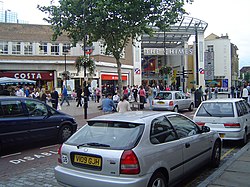 The Chimes and Uxbridge High Street | |
| Location | |
| Grid reference: | TQ055835 |
| Location: | 51°32’25"N, 0°28’40"W |
| Data | |
| Post town: | Uxbridge |
| Postcode: | UB8 |
| Dialling code: | 01895 |
| Local Government | |
| Council: | Hillingdon |
| Parliamentary constituency: |
Uxbridge and South Ruislip |
Uxbridge is a town at the very western border of Middlesex. It is a commuter town, at the end of the Uxbridge Branch of the Metropolitan Line. Fifteen miles west-north-west of Charing Cross, it is one of the major metropolitan centres identified in the London Plan.[1] The landscape upon which Uxbridge was established is largely unchanged from the Mesolithic era: Much of it was covered by oak and elm trees, which were gradually cleared by early settlers. An archaeological excavation by the Museum of London in the 1990s found evidence of flint items shaped by Mesolithic hunters, as well as various animal bones and traces of charcoal from the remains of campfires.[2]
It is a significant retail and commercial centre, and is the location of Brunel University and the Uxbridge campus of Buckinghamshire New University.[3] The town is close to the boundary with Buckinghamshire, which is locally the River Colne. The River Pinn runs through Uxbridge, joining the Frays River, which branches off from the Colne.
Several historical events have taken place in and around the town, including attempted negotiations between King Charles I and the Parliamentary Army during the Civil War. The public house at the centre of those events, since renamed the Crown & Treaty, still stands. Uxbridge also houses the Battle of Britain Bunker, from where the air defence of the south-east was coordinated during the Battle of Britain. Situated in RAF Uxbridge, the No. 11 Group Operations Room within the bunker played a crucial rule during the battle and was later used during the D-Day landings.
History
Toponymy
The name of the town is derived from "Wixan's Bridge",[4] which was sited near the bottom of Oxford Road where a modern road bridge now stands, beside the Swan and Bottle public house.[5] The Wixan were a 7th-century Saxon tribe from Lincolnshire who also began to settle in what became Middlesex.[2] Anglo-Saxons began to settle and farm in the area of Uxbridge in the 5th century, clearing the dense woodland and remaining there for around 500 years.[2] Two other places in Middlesex bore the name of the Wixan: Uxendon ("Wixan's Hill"), a name now preserved only in the street names of Uxendon Hill and Crescent in Harrow, and Waxlow ("Wixan's Wood") near Southall.[6]
Archaeologists found Bronze Age remains (before 700 BC) and mediæval remains during the construction of The Chimes shopping centre; two miles away at Denham, Upper Paleolithic remains have been found. Uxbridge is not mentioned in the Domesday Book of the 11th century, but a hundred years later the existing church, St Margaret's, was built. The town appears in records from 1107 as "Woxbrigge", and became part of the Elthorne Hundred with other settlements in the area.[7]
Early developments
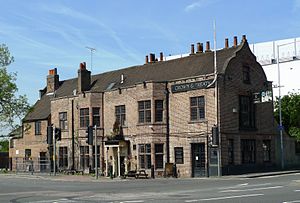
The Parliamentary Army garrisoned the town upon the outbreak of the Civil War in 1642 and established their headquarters there in June 1647 on a line from Staines to Watford,[8] although the king passed through Uxbridge in April 1646, resting at the Red Lion public house for several hours.[9] Charles I met with representatives of Parliament at the Crown Inn in Uxbridge in 1645, but negotiations for the end of hostilities were unsuccessful due in part to the king's stubborn attitude.[8] The town had been chosen as it was located between the Royal headquarters at Oxford and the Parliamentary stronghold of London.[10]
The covered market was built in 1788, replacing a building constructed in 1561.[11] In the early 19th century, Uxbridge had an unsavoury reputation; the jurist William Arabin said of its residents "They will steal the very teeth out of your mouth as you walk through the streets. I know it from experience." For about 200 years most of London's flour was produced in the Uxbridge area.[12]
The Grand Junction Canal opened in 1794, linking Uxbridge with Birmingham. By 1800 Uxbridge had become one of the most important market towns in Middlesex, helped by its status as the first stopping point for stagecoaches travelling from London to Oxford. The development of Uxbridge declined after the opening of the Great Western Railway in 1838, which passed through West Drayton. A branch line to Uxbridge was not built until 1904.[13]
Harman's Brewery was established in Uxbridge by George Harman in 1763, and moved into its new headquarters in Uxbridge High Street in 1875. The eventual owners of the brewery, Courage, closed the headquarters in 1964. It was demolished and replaced by a Budgen's supermarket, which in turn was demolished with the construction of The Chimes shopping centre. The brewery building in George Street remained in place until it was demolished in 1967.[14] The office building Harman House was built on the site in 1985, named after the brewery.[15]
Urban development
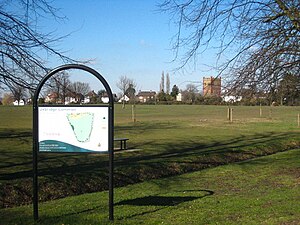
The enclosure of Hillingdon Parish in 1819 saw the reduction in size of Uxbridge Common, which at its largest had been four miles in circumference. The common originally covered both sides of Park Road to the north of the town centre but now covers 15 acres.[16]
In 1871 the town's first purpose-built police station was built in Windsor Street. The building included three cells and stables.[17] The Metropolitan Police continued to use the building until 1988, when operations moved to a new site in Harefield Road. The building subsequently became the Old Bill public house in 1996, renamed the Fig Tree in 2006.[18]
In the early 1900s the Uxbridge and District Electricity Supply Company had been established in Waterloo Road, and much of the town was connected by 1902, although some houses still had gas lighting in 1912. A water tower on Uxbridge Common was built in 1906, resembling a church tower, to improve the supply to the town.[19]
Wood panelling from a room in the Crown & Treaty public house was sold in 1924 to an American businessman, who installed it in his office in the Empire State Building in New York. It was returned in 1953 as a gift to the newly crowned Queen Elizabeth II and returned to the house, although the monarch retained ownership.[20]
On 31 August 1935 Uxbridge Lido, an outdoor swimming pool built in the "Moderne" or Art Deco style, was officially opened. Before the opening, many residents swam in a section of the Frays River near Harefield Road,[21] and the Colne.[22] The pool, pavilion building, entrance building and both fountains were designated Grade II listed buildings in 1998. Despite the listing, the pool was closed to the public and the buildings became subject to heavy vandalism.[23] Uxbridge open-air pool was fully refurbished during 2009 and re-opened in May 2010. Added to the site, now named Hillingdon Sports and Leisure Complex, is a 50 m indoor competition pool, a leisure pool, a 100-station gym, a wide range of exercise classes, an athletics stadium and track, 3G floodlit pitches, a sports hall, a café and a crèche. The Grade II listed buildings are still standing.
During the Second World War Uxbridge adopted the Royal Navy destroyer HMS Intrepid in 1942, to help towards the ship's costs; Intrepid was lost to enemy action the following year.[24] The town and surrounding areas suffered bombing by the Luftwaffe. V1 flying bombs fell on the town between June 1944 and March 1945. The first recorded bombing using a V1 was on 22 June 1944 at 07:00, when the bomb passed over the top of a bus and hit four houses nearby. Seven people were killed and 25 injured, leaving 46 houses in the area uninhabitable.[25]
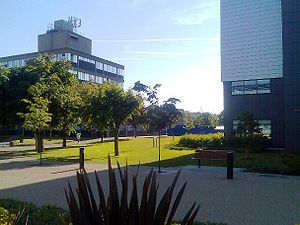
In 1958 the 199-acre Lowe & Shawyer plant nursery to the west of RAF Uxbridge entered voluntary liquidation. The nursery had stood in Kingston Lane since 1868, and was the largest producer of cut flowers in the country.[26] Demolition work began in 1962, and the construction of Brunel University commenced.[27] Chrysanthemums are included the coat of arms of the Borough of Uxbridge in memory of the nursery.[28] The Uxbridge (Vine Street) railway branch line, which partly ran alongside the site, was closed in 1964 and in 1966 the university opened,[29] purchasing the land where the railway had run from the local council for £65,000.[30]
Uxbridge Cricket Club moved from Cricketfield Road in 1971 to make way for the new Civic Centre.[31] The club had been at Cricketfield Road since 1858, but moved to a new site on part of Uxbridge Common on Park Road.[32] The Market Square shopping precinct in the town centre was built in the late 1970s, but its lack of shelter made it unpopular and it did not attract the expected levels of custom. Many buildings along the High Street and Windsor Street had been demolished to make way for the new precinct,[33] which was eventually sold to the Prudential Assurance Company and redeveloped with a roof in the early 1980s to become the Pavilions Shopping Centre.[29] The Peacock public house in one of the two main squares was demolished and replaced with a café named The Chequers, which remains.[34] Rayner's pharmacy shop was also demolished during the Market Square development, although the shopfront was saved by the Museum of London and is held in storage.[35]
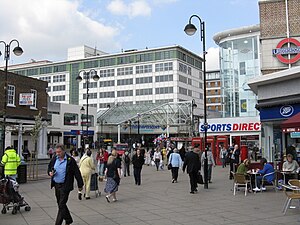
The Chimes shopping centre was built beside Uxbridge station in 2001, incorporating many of the existing buildings into the new structure. The centre was originally to be named St George's Centre in plans dating back to the early 1990s, though this name was eventually taken by another shopping centre in Harrow on the Hill. Instead, The Chimes was said to refer to the sound of the bells from the nearby market house on the High Street.[36] An Odeon cinema opened as a major part of the centre, with the smaller cinema at the opposite end of the High Street closing.[37] Some houses on Chippendale Way and the St George's car park were demolished to allow for the construction of the new shopping centre car park.[38] The offices of the local building company Fassnidge were also included in the new development; built in the 19th century, they now house a Pizza Express restaurant. Preserved timber from earlier demolished buildings in Uxbridge was used in the construction of a new building beside the former offices of Fassnidge, designed to resemble a much older structure.[39]
In 2002 the dry ski slope near Park Road and the Uxbridge Lido was closed and the remaining buildings and structures removed. The Hillingdon Ski Centre had been subject to several arson attacks during 2001 and the company operating it became insolvent. The slope, which had been built in 1977, was left to return to nature.[40]
Work began in 2008 to extensively refurbish and extend Uxbridge Lido, and it reopened to the public in February 2010 as the Hillingdon Sports and Leisure Complex.[41] On 8 September 2010 the 75th anniversary of the first opening of the Lido was celebrated at the pool.[42]
Churches
St Margaret's Church
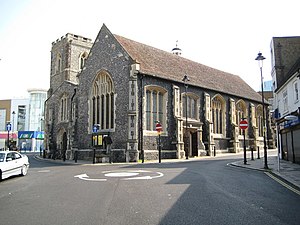
This is the original parish church of Uxbridge, and one of the oldest buildings in the town. Located in Windsor Street, it is known to have existed since at least 1245, when a series of hearings took place there in which the Abbot of Bec in Normandy brought an action against the rector of Great Wratting in Suffolk for non-payment of tithes. On parchments kept at |St George's Chapel, Windsor, in connection with this event, St Margaret's is mentioned by name, and there are several other references between 1245 and 1247 to the "chapel at Uxbridge".[43]
The oldest portion of the existing building is part of the north tower, which was built in the late 14th century. The north aisle, together with the nave and its arcades, dates from the early 15th century, while the south aisle, with its fine hammer-beam roof, was added about 1450. The carved stone font was placed in the church soon afterwards, dating from about 1480.[43]
For most of its history, St Margaret's served as a chapel-of-ease to St John the Baptist's Church in Hillingdon; it was not until 1827 that it was given its own parish.[44]
St Andrew's Church
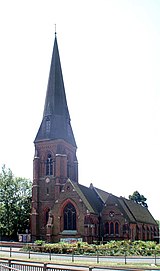
By the 1850s the population of both Hillingdon and Uxbridge was beginning to rise. With new housing being built between the two centres the then Vicar of Hillingdon, the Rev Richard Croft (1856–69) gained permission to build a new church in the area, sometimes referred to as Hillingdon West. He asked the well-known architect Sir George Gilbert Scott:
"to draw up plans to build a church without unnecessary ornament but in handsome proportions suitable to its position at the entrance to Uxbridge Town..."
Scott produced his plans and local Uxbridge builder William Fassnidge was employed to construct the church. On St Peter’s Day, 29 June 1864, the foundation stone was laid at the south end of the chancel arch by the Lord Bishop of London, Archibald Campbell Tait. He returned less than a year later to consecrate and open the church on the feast of SS Philip and James, 1 May 1865.[45]
The spire was completed the following year. Together with the bells, vestry and organ and other embellishments, the cost of the building, located in Hillingdon Road, was some £12,000.[45]
Church of Our Lady of Lourdes and St Michael
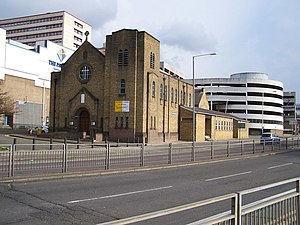
After St Margaret's turned Protestant in the 16th century, there was no official Roman Catholic place of worship in Uxbridge until the late 19th century, following the passing of the Catholic Emancipation Act. In 1892 Father Michael Aloysius Wren bought a presbytery at 37 Lawn Road, next to which a temporary church was built of corrugated iron, dedicated to Our Lady of Lourdes and St Michael. St Mary’s School was also founded on Rockingham Road at this time. Fr Wren was helped by his nephew John, who acted as his assistant priest. They covered an extensive area, including the modern Catholic parishes of Ruislip and Hillingdon.[46]
The mission grew from strength to strength and by 1907 the congregation numbered 150, with school attendance at 60. In time plans were made for a larger, more permanent church. This was the brainchild of Father Thomas Moloney, who bought the current presbytery and acquired the land that stood at the back so that a church could be built. The foundation stone was eventually laid on Low Sunday 1931 by Archbishop Alban Goodier, a Jesuit who had been Archbishop of Bombay between 1919 and 1926. The new church, in Oxford Road, was designed by the diocesan architect, T. H. B. Scott. It was built of brick in the Romanesque style, seating 350. The church was built quickly and opened by Cardinal Bourne on 29th September 1931. It was officially consecrated on 14 May 1936, after its debts were cleared.[47]
Economy
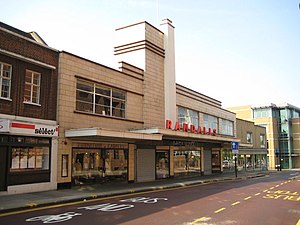
Uxbridge has two shopping centres, The Pavilions and [ntu Uxbridge (formerly The Chimes). Much of the town centre is pedestrianised. Just off the High Street is Windsor Street, a short road populated by older shops. A notable landmark on the road is Randalls, the Art Deco-style former department store owned by the family of the former MP for Uxbridge and South Ruislip, John Randall. The present store was constructed in 1939 on the site of another that had been built in 1900.[48] It was awarded Grade II listed status in October 2008.[49] The store closed in January 2015 following a decline in trade.[50]
The town centre consists of retail outlets and a number of office buildings, including the main European offices of international companies such as Canon, PricewaterhouseCoopers, Apple, WMS Gaming, Unisys,[51] Kuehne + Nagel, PAREXEL,[52] Xerox, Arri, Bristol-Myers Squibb, Monster Energy, APL, Herbalife Europe and Anixter International.[53] Other employers include NetApp,[54] IBB Solicitors, F. Hinds, [he Coca-Cola Company, Coca-Cola Enterprises,[55] General Mills[56] and Nexen. Cadbury plc moved its head office to Uxbridge from Mayfair in January 2008.[57] The company announced the plan in 2007 as part of efforts to cut costs.[58]
Education
Uxbridge High School is a comprehensive secondary school in the town.[59]
Uxbridge is also home to Brunel University and the Buckinghamshire New University's nursing campus.[60] The main campus of Uxbridge College is also in the town.[61]
Transport
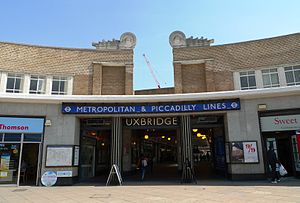
Uxbridge tube station is the western terminus for branches of the Metropolitan and Piccadilly lines of the London Underground. The station, built in 1933, is fronted by a pedestrian high street and is connected to a bus terminus with connections to Hillingdon, Hayes, Ealing, Ruislip, and Slough.
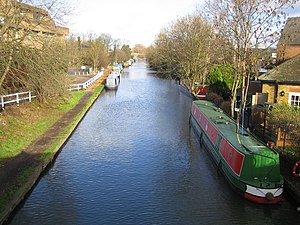
There were once two railway stations: Uxbridge Vine Street (originally just Uxbridge Station) and Uxbridge High Street. Both were planned to be linked, hence High Street ending on a half-built bridge.[62] High Street closed to passengers as a war economy and never reopened. Despite having the most intensive service, the Vine Street line was one of the first Western Region urban branches to close under the Beeching axe. Uxbridge Belmont Road was the first underground station, built slightly outside the town centre to allow for a possible extension to High Wycombe. This was subsequently replaced by the current station.[63]
The Grand Union Canal, formerly the Grand Junction Canal, connects London with Birmingham and passes immediately to the west of Uxbridge, forming part of the borough boundary. The first stretch was built in the late 18th century from Brentford to Uxbridge. Further upstream is Uxbridge Lock, and nearby is a derelict flour mill formerly owned by Allied Mills. The mill was bought in the 19th century by William King, who named it "Kingsmill".[64] Kingsmill continues to be used as a brand of bread by Associated British Foods.[65]
Landmarks
Civic Centre
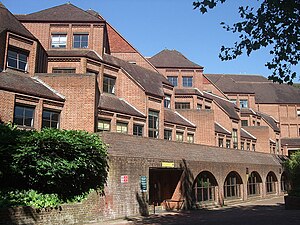
The Hillingdon Civic Centre was built in Uxbridge High Street in 1973. Before the new building was completed, council services had been spread throughout Uxbridge and the rest of the borough and various buildings, as a result of the merging of the former district councils.
Part of the original Middlesex County Council office building that stood on site was incorporated into the new Civic Centre. The centre's clock tower is the only visible section from the old building. The Uxbridge Cricket Club Ground and Uxbridge fire station were relocated as part of the new development, which became controversial owing to its size and cost. Areas of the building, particularly the council chambers, continue to suffer from poor acoustics.[66]
Uxbridge Magistrates' Court
The original Magistrates' Court opened in 1907 in an Edwardian style. A new building with little exterior styling opened nearby in the 1990s and legal proceedings were transferred.[67]
RAF Uxbridge, Battle of Britain Bunker and Hillingdon House
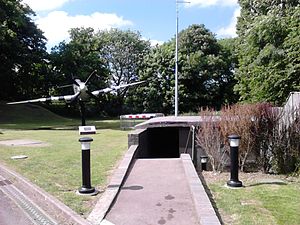
Uxbridge had a Royal Air Force station, known as RAF Uxbridge, until its closure on 31 March 2010. The station was built within the grounds of Hillingdon House, a 19th-century mansion bought by the British government in 1915,[68] and became most famous as the home of RAF Fighter Command's No. 11 Group Operations Room during the Battle of Britain. Fighter squadrons at airfields in the south-east of England were directed from the station, which was visited by Prime Minister Winston Churchill during the battle, and other foreign leaders throughout the rest of the war.[69]
Following the station's closure, the replica No. 33 Squadron Supermarine Spitfire gate guardian was removed from the main entrance for restoration work and moved to the entrance of the Operations Room (now known as the Battle of Britain Bunker). The area around the bunker was retained as an enclave under the RAF Uxbridge name, under the care of RAF Northolt. An additional guardian, a Hawker Hurricane in the colours of No. 303 (Polish) Squadron, was added to the area in November 2010.[70]
Sport and leisure
Uxbridge has a football team, Uxbridge F.C., which plays at Honeycroft, West Drayton.[71] Uxbridge Cricket Club is also based in Uxbridge and is a member of the Middlesex County Cricket League, a designated ECB Premier League. Hillingdon Sports and Leisure Complex has recently been refurbished and contains an indoor and outdoor swimming pool, an athletic track and large sports complex. The South Korean Olympic Team used the centre for training during the 2012 Olympic Games.[72]
Notable people
A number of notable people have lived in Uxbridge.
Christine Keeler, the 1960s model who became involved in the 1963 Profumo Affair, was born here,[73] as was the actor, writer and director Bernard Miles (1907–1991), who attended Bishopshalt Grammar School.[74] Also born here was the poet, novelist and illustrator Peggy Eileen Whistler (1909–1958), who used the pseudonym Margiad Evans,[75] and John Stears (1934–1999), the Academy Award-winning creator of James Bond's Aston Martin DB5 and Star Wars robots.[76]
References
Citations
- ↑ "London Plan (Consolidated with Alterations since 2004)". Greater London Authority. 2008. p. 351. http://www.london.gov.uk/thelondonplan/docs/londonplan08.pdf. Retrieved 10 November 2011.
- ↑ 2.0 2.1 2.2 Cotton 1994, p. 8.
- ↑ "About us". Buckinghamshire New University. 2013. http://bucks.ac.uk/about_us/. Retrieved 31 March 2013..
- ↑ "Uxbridge". Key to English Place Names. English Place Name Society. http://kepn.nottingham.ac.uk/map/place/Middlesex/Uxbridge. Retrieved 10 May 2012.
- ↑ Pearce 2011, p. 7.
- ↑ P. H. Reaney (1969). The Origin of English Place Names. Routledge and Kegan Paul. p. 103. ISBN 0-7100-2010-4..
- ↑ Sherwood 2007, p. 5.
- ↑ 8.0 8.1 Cotton 1994, p. 23.
- ↑ Cotton 1994, p. 25.
- ↑ Cotton 1994, p. 22.
- ↑ Sherwood 2007, p. 53.
- ↑ Cotton 1994, p. 32.
- ↑ Sherwood 2007, p. 6.
- ↑ Sherwood 2007, p. 43.
- ↑ Sherwood 2007, p. 44.
- ↑ Sherwood 2007, p. 71.
- ↑ "49, The Fig Tree (formerly The Old Bill)". London Borough of Hillingdon. 2009. p. 1. http://www.hillingdon.gov.uk/media/pdf/3/7/275_49__The_Fig_Tree__Windsor_Street.pdf. Retrieved 17 June 2011.
- ↑ Pearce 2011, p. 54.
- ↑ Cotton 1994, p. 105.
- ↑ Cotton 1994, p. 24.
- ↑ Skinner 2008, p. 30.
- ↑ Cotton 1994, p. 121.
- ↑ Sherwood 2007, p. 72.
- ↑ Cotton 1994, p. 129.
- ↑ Skinner 2008, p. 107.
- ↑ Sherwood 2007, p. 39.
- ↑ Pearce 2009, p. 95.
- ↑ Cotton 1994, p. 113.
- ↑ 29.0 29.1 Cotton 1994, p. 138
- ↑ "Annual Report 2005". Brunel University. 2005. p. 15. http://www.brunel.ac.uk/__data/assets/pdf_file/0006/26547/Annual_Report_2005.pdf. Retrieved 5 May 2011..
- ↑ Cotton 1994, p. 64.
- ↑ Skinner 2008, p. 27.
- ↑ Sherwood 2007, p. 47.
- ↑ Sherwood 2007, p. 50.
- ↑ Sherwood 2007, p. 46.
- ↑ Sherwood 2007, p. 58.
- ↑ Sherwood 2007, p. 59.
- ↑ Sherwood 2007, p. 64.
- ↑ Sherwood 2007, pp. 62–63.
- ↑ "Apres-ski". Hillingdon & Uxbridge Times. 6 February 2002. http://www.hillingdontimes.co.uk/archive/2002/02/06/Local+London+Archive/6367862.Apres_ski/. Retrieved 22 July 2011.
- ↑ "Hillingdon Sports and Leisure Complex". London Borough of Hillingdon. 9 March 2010. http://www.hillingdon.gov.uk/index.jsp?articleid=11050. Retrieved 4 April 2011.
- ↑ Coombs, Dan (8 September 2010). "Uxbridge Lido celebrates 75th anniversary". Uxbridge Gazette. http://uxbridge.uxbridgegazette.co.uk/2010/09/uxbridge-lido-celebrates-75th.html. Retrieved 18 April 2011.
- ↑ 43.0 43.1 "Uxbridge History - St Margaret's Church". Alan Rix. http://www.alanrix.pwp.blueyonder.co.uk/smhist.html. Retrieved 13 December 2015.
- ↑ Weinreb, Ben and Hibbert, Christopher (1992). The London Encyclopaedia (reprint ed.). Macmillan. p. 753.
- ↑ 45.0 45.1 "St Andrew's Church Uxbridge - History". official website. http://www.standrewsuxbridge.org/about-us/st-andrews-history. Retrieved 13 December 2015.
- ↑ "Catholic Church Uxbridge - The Beginning of the Modern Parish". Official website. http://www.catholicchurchuxbridge.org.uk/the-beginning-of-the-modern-parish.html. Retrieved 14 December 2015.
- ↑ "Catholic Church Uxbridge - A New Church". Official website. http://www.catholicchurchuxbridge.org.uk/a-new-church.html. Retrieved 14 December 2015.
- ↑ Pearce 2011, p. 61
- ↑ "Randalls Department Store, Uxbridge". British Listed Buildings. http://www.britishlistedbuildings.co.uk/en-504370-randalls-department-store-uxbridge. Retrieved 15 May 2011.
- ↑ Hayes, Alan (11 December 2014). "End of an era as Randall's of Uxbridge closes". Uxbridge Gazette. http://www.getwestlondon.co.uk/news/local-news/end-era-randalls-uxbridge-closes-8267279. Retrieved 7 September 2015.
- ↑ "Coca-Cola take Office Space at Uxbridge Town Centre". Office Broker. 7 September 2010. http://www.officebroker.com/blog/2010/09/07/Coca-Cola+take+Office+Space+at+Uxbridge+Town+Centre_FTOC07092010476540E/. Retrieved 31 October 2012.
- ↑ "Europe: United Kingdom". PAREXEL International. 2012. http://www.parexel.com/about/global-presence/europe/united-kingdom/. Retrieved 20 November 2012..
- ↑ "United Kingdom". Anixter International. 2012. http://www.anixter.com/content/anixter/emea/euc/en/about-us/contact-us/global-locations-contact-info/europe/united-kingdom.html. Retrieved 20 November 2012.
- ↑ "NetApp UK Contact Us". NetApp UK Ltd. 2014. http://www.netapp.com/uk/contact-us/. Retrieved 30 October 2014..
- ↑ "Uxbridge, GB and European HQ". Coca-Cola Enterprises Ltd. 2012. http://www.cokecce.co.uk/about-us/sites-and-offices/uxbridge,-gb-and-european-hq.aspx. Retrieved 31 January 2012..
- ↑ "Frequently asked". General Mills UK & Ireland. 2012. http://www.generalmills.co.uk/gmi/level2page.aspx?pagenumber=24. Retrieved 20 November 2012..
- ↑ "Cadbury plc Confirms Strong Start to 2008". Investis. 19 June 2008. http://files.investis.com/cbry/08interim_trd/interim_jun08/interimstatementjune08.html. Retrieved 31 October 2012..
- ↑ Muspratt, Caroline. "Cadbury swaps Mayfair for Uxbridge." The Daily Telegraph. 1 June 2007. Retrieved on 27 April 2010.
- ↑ "Uxbridge High School". Uxbridge High School. 2012. http://www.uhs.org.uk/. Retrieved 11 September 2012..
- ↑ "School of Pre-Qualifying Nursing". Buckinghamshire New University. 2013. http://bucks.ac.uk/whoswho/school_of_pre-qualifying_nursing/. Retrieved 31 March 2013.
- ↑ "Contact details for Uxbridge College (Uxbridge Campus)". London Borough of Hillingdon. 15 October 2009. http://www.hillingdon.gov.uk/index.jsp?articleid=9718. Retrieved 23 April 2011..
- ↑ Cotton 1994, p. 102.
- ↑ Pearce 2009, p. 51.
- ↑ "Uxbridge Lock Conservation Area Character Appraisal". South Bucks District Council. January 2008. http://www.southbucks.gov.uk/includes/documents/cm_docs/2009/u/uxbridge_lock_conservation_january_2008.pdf. Retrieved 11 September 2012..
- ↑ "Overview". Associated British Foods. 2013. http://www.abf.co.uk/about_us/our_group/overview?#section_af3d1119e5a94196bd11c2cf21192430. Retrieved 31 March 2013..
- ↑ Sherwood 2007, p. 36.
- ↑ Sherwood 2007, p. 32.
- ↑ Crozier 2007, p. 5
- ↑ Crozier 2007, p. 29.
- ↑ "Refurbished Guardian". Royal Air Force. 25 November 2010. http://www.raf.mod.uk/news/archive.cfm?storyid=254B4BBF-5056-A318-A813BB0F6CB4ADE8&rss=true. Retrieved 15 March 2011..
- ↑ "Location". Pitchero. 2012. http://www.pitchero.com/clubs/uxbridge/location/. Retrieved 16 November 2012.
- ↑ "Hillingdon Sports & Leisure Complex to host South Korea Olympics team". Fusion Lifestyle. 17 July 2012. http://www.fusion-lifestyle.com/centres/Hillingdon_Sport_and_Leisure_Complex%20/news/001_Hillingdon_Sports_Leisure_Complex_to_host_South_Korea_Olympics_team. Retrieved 11 September 2012.
- ↑ Staff Reporter (1 July 2003). "Christine Keeler: Born in Uxbridge 2 February 1942". Leigh Journal. http://www.leighjournal.co.uk/news/388273.osborne_targets_banking_overhaul/. Retrieved 11 September 2012..
- ↑ "Lord Bernard Miles". London Borough of Hillingdon. 30 September 2011. http://www.hillingdon.gov.uk/index.jsp?articleid=22429. Retrieved 11 September 2012./
- ↑ ODNB: Ceridwen Lloyd-Morgan: "Williams , Peggy Eileen [Margiad Evans] (1909–1958)" Retrieved 1 July 2010, pay-walled.
- ↑ "Michael John Stears". London Borough of Hillingdon. 27 October 2011. http://www.hillingdon.gov.uk/index.jsp?articleid=23929. Retrieved 11 September 2012..
Bibliography
- Bainbridge, John. (2001) Middlesex Photographic Memories. Salisbury: Frith Book Company ISBN 1-85937-158-2
- Cotton, Carolynne. (1994) Uxbridge Past. London: Historical Publications ISBN 0-948667-30-3
- Crozier, Hazel. (2007) RAF Uxbridge 90th Anniversary 1917–2007. RAF High Wycombe: Air Command Media Services
- Hearmon, Carolynne. (1982) Uxbridge. A Concise History. Uxbridge: Hillingdon Borough Libraries ISBN 0-907869-06-8
- Pearce, K. R. (2009) Uxbridge From Old Photographs. Stroud: Amberley Publishing ISBN 978-1-84868-390-7
- Pearce, K. (2011) Uxbridge Through Time. Stroud: Amberley Publishing ISBN 978-1-4456-0522-7
- Sherwood, Philip. (2007) Around Uxbridge Past & Present. Stroud: Sutton Publishing ISBN 978-0-7509-4794-7
- Skinner, James. (2008) Growing Up In Wartime Uxbridge. Stroud: Tempus Publishing ISBN 978-0-7524-4543-4
Further reading
- Edward Walford (1883), "Uxbridge", Greater London, London: Cassell & Co., OCLC 3009761, http://archive.org/stream/greaterlondonnar01walf#page/230/mode/1up
| ("Wikimedia Commons" has material about Uxbridge) |
